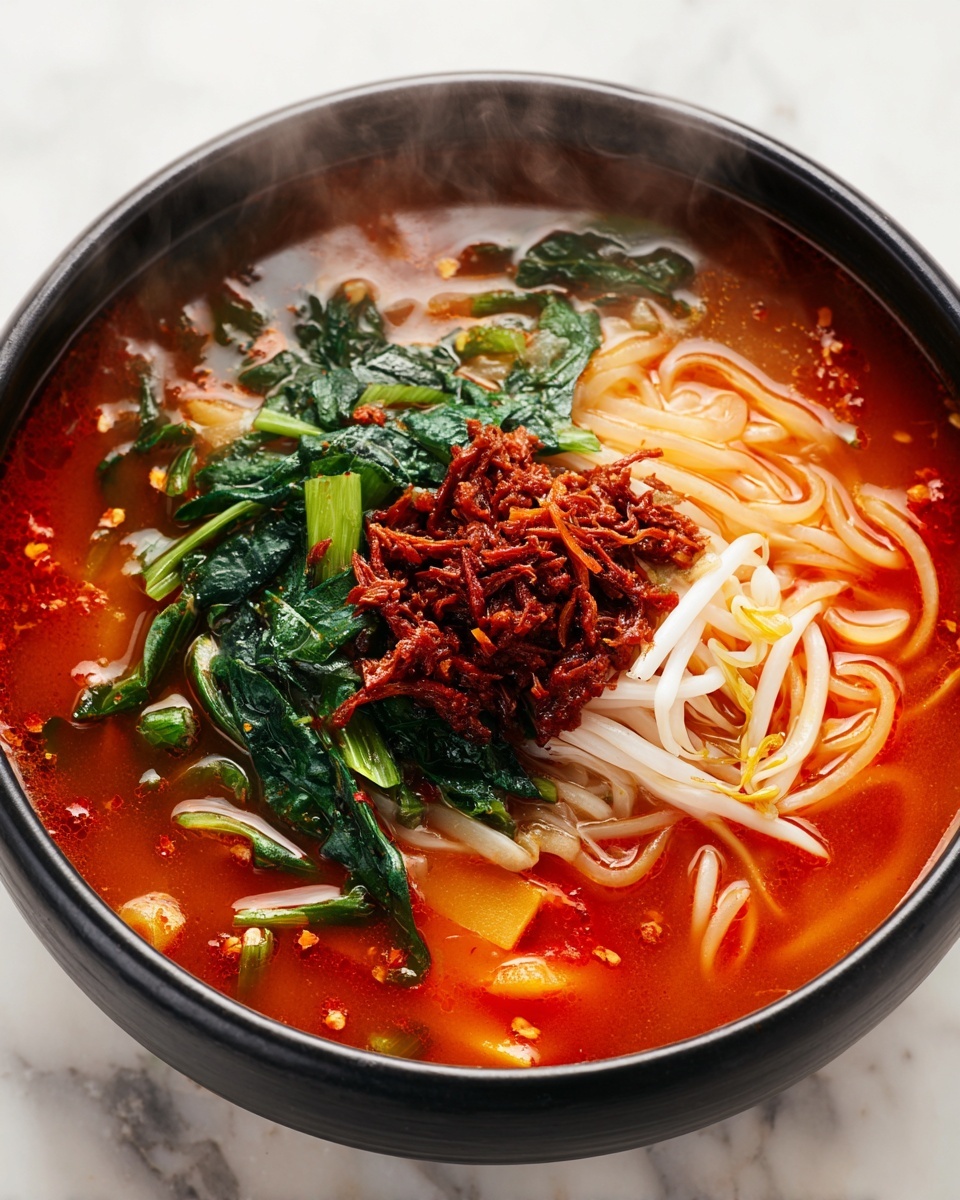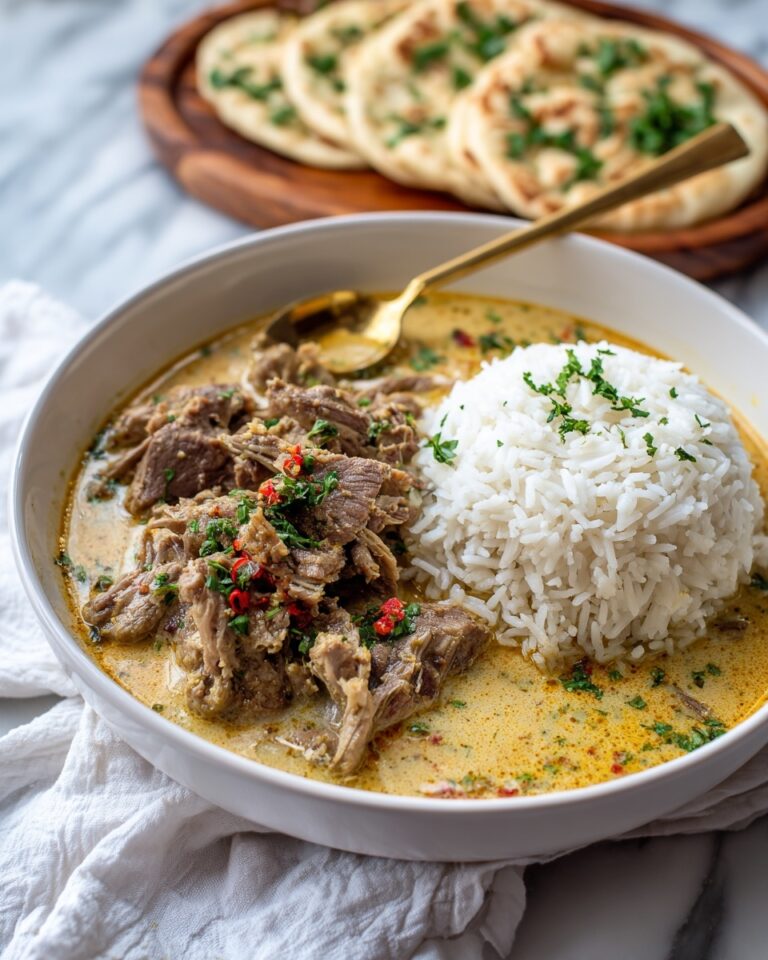If you are craving a bowl of rich, warming comfort food with a zesty kick, this Korean Spicy Beef Vegetable Soup Recipe will quickly become your new favorite. The combination of tender beef brisket, a medley of fresh and rehydrated vegetables, and a perfectly balanced spicy broth filled with traditional Korean flavors creates something truly magical. Each spoonful wraps you in deep, savory goodness, peppered with just the right amount of heat to wake up your taste buds without overpowering them. This soup is a celebration of texture, color, and authentic Korean cooking that’s both hearty and nourishing.
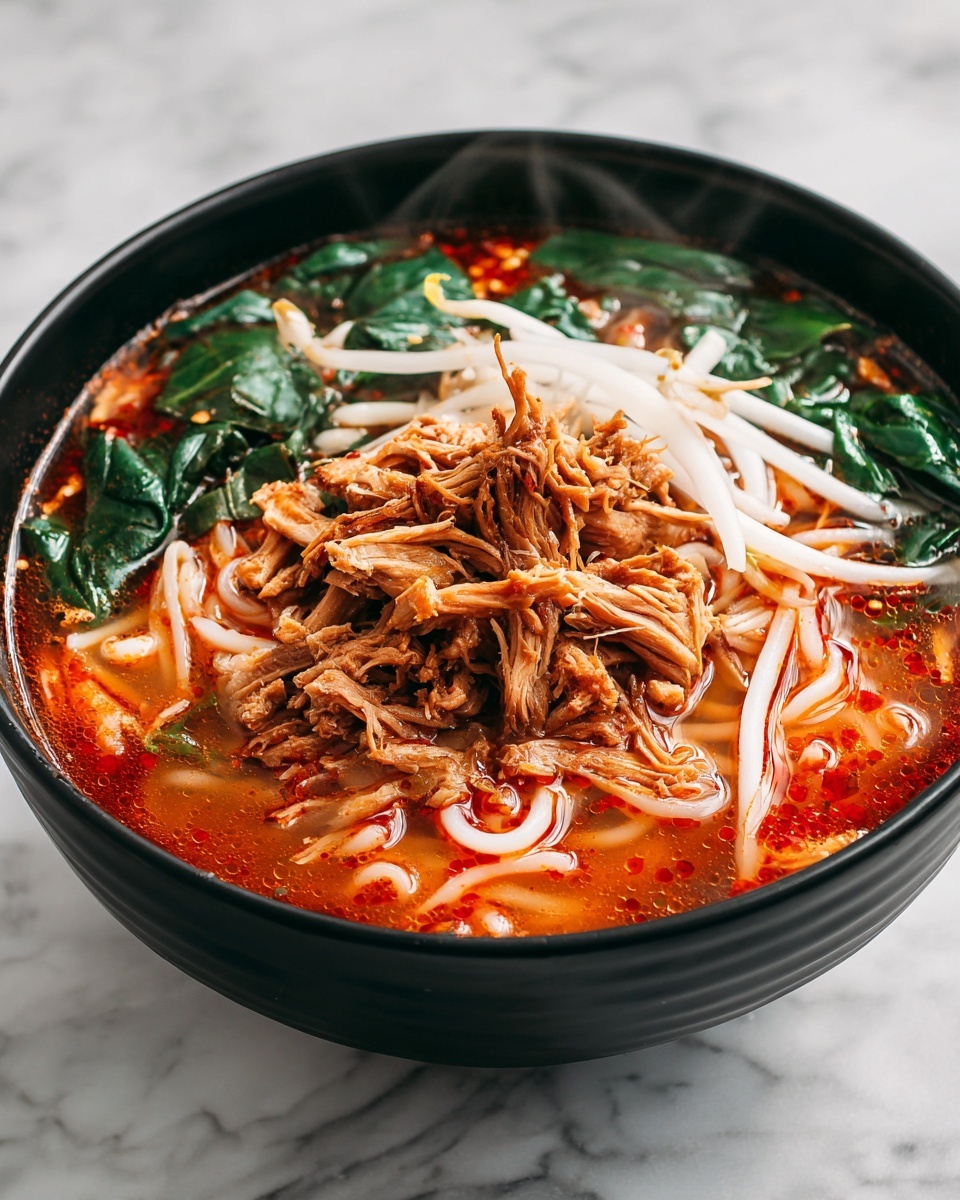
Ingredients You’ll Need
The ingredients for this Korean Spicy Beef Vegetable Soup Recipe may sound simple, but each plays a vital role in building layers of flavor, texture, and authenticity. From the chewy dried fernbrake to the juicy fresh mushrooms, everything is thoughtfully chosen to come together into one beautifully balanced dish.
- Dried fernbrake (0.8 oz/22g): Adds an earthy, slightly nutty flavor with a unique chewy texture once rehydrated.
- Dried taro stem (1 oz/28g, optional): A traditional ingredient that offers subtle crunch and depth; feel free to skip if unavailable.
- Mung bean sprouts (8 oz/225g): Give a refreshing crispness and lightness to the soup’s hearty character.
- Oyster mushrooms (5 oz/140g): Bring an umami richness and delicate bite that complements the beef beautifully.
- Asian leeks (2 stalks): Deliver gentle sweetness and aromatic layers to the broth.
- Garlic cloves (3, minced + 1 whole for stock): Essential for that pungent kick and deep complexity.
- Korean chili paste (gochujang, 1 teaspoon): Adds depth, sweetness, and the signature Korean spicy flair.
- Soy sauce (1 tablespoon): Balances the heat with salty umami notes.
- Korean soup soy sauce (gukganjang, 3 tablespoons): A darker, richer soy sauce perfect for soup bases.
- Korean anchovy sauce (1 1/2 tablespoons): Intensifies savory flavors and brings authentic seafood undertones.
- Salt and pepper: Adjusts seasoning to your personal taste.
- Beef brisket (1 1/4 lb/560g): Slow-cooked until tender, it’s the heart of this soup.
- Large onion (1, halved): Contributes natural sweetness and depth to the broth.
- Korean radish (1/2 lb/225g, cut into chunks): Adds a subtle peppery sweetness and soft texture.
- Water (14 cups/about 3 liters): The base that transforms all ingredients into a rich soup.
- Oil (2 tablespoons) + sesame oil (2 tablespoons): Used for making fragrant chili oil to enliven the broth.
- Korean chili flakes (gochugaru, 3-4 tablespoons): Give the soup its vibrant red color and perfect spicy heat.
How to Make Korean Spicy Beef Vegetable Soup Recipe
Step 1: Rehydrate the Dried Vegetables
Start by boiling the dried fernbrake and taro stem separately until they soften beautifully—this usually takes a good soak of about one hour. Afterwards, give them a thorough rinse and slice them thinly. This step is crucial for bringing out the right texture and mellow flavor from these unique ingredients that add authenticity to the dish.
Step 2: Make the Beef Stock
In a large stockpot, combine the onion (halved), the whole garlic clove (also halved), Korean radish chunks, and your beef brisket, then pour in the water. Bring this to a boil then lower to a simmer for about 45 minutes. This slow cooking breaks down the beef, infusing the broth with deep beefy goodness. Once finished, remove and discard the veggies, shred the beef, and strain the broth so it’s beautifully clear and flavorful.
Step 3: Blanch Fresh Vegetables
Prepare your fresh ingredients next. Slice the Asian leeks, and quickly blanch the mung bean sprouts, the oyster mushrooms, and the leeks in boiling salted water for just a few seconds. This gentle blanching keeps their vibrant color and slight crunch alive. Drain, rinse under cold water, and squeeze out any excess moisture to avoid watering down the soup.
Step 4: Make the Chili Oil
For the spicy, aromatic kick, heat a mixture of regular oil and sesame oil on low heat in a pot. Add in the Korean chili flakes (gochugaru) and stir continuously for about 30 seconds—just enough to release the chili’s aroma without burning it. This fiery oil is the cornerstone of the soup’s vibrant flavor and eye-catching color.
Step 5: Combine and Simmer
Now, add the shredded beef and all the prepared vegetables back into the pot with chili oil. Pour in the reserved beef stock slowly and stir in the teaspoon of gochujang. Let everything simmer gently for 15 to 20 minutes so the flavors meld together perfectly, creating a rich, balanced broth infused with spicy, savory layers.
Step 6: Season the Soup
Lastly, season your soup with soy sauce, Korean soup soy sauce (gukganjang), and anchovy sauce for authentic depth. Taste and add salt and pepper as needed. The seasoning here is what ties the entire Korean Spicy Beef Vegetable Soup Recipe together, highlighting the harmony of spicy, salty, and umami notes in every spoonful.
How to Serve Korean Spicy Beef Vegetable Soup Recipe
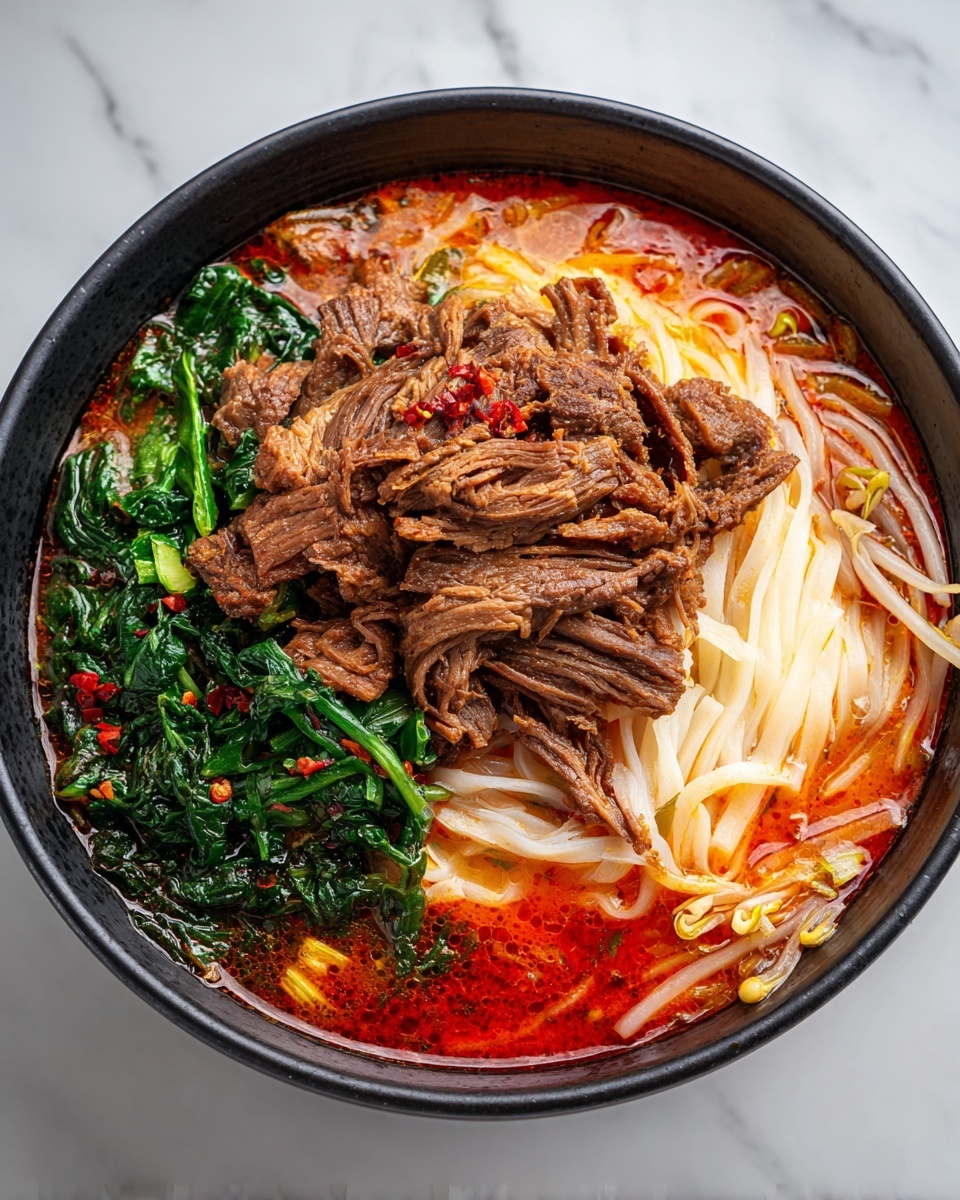
Garnishes
To elevate your soup experience, adorn your bowl with freshly chopped green onions, a sprinkle of toasted sesame seeds, or some thinly sliced chili pepper if you love extra heat. These simple garnishes add a pop of freshness and textural contrast, making each bite even more exciting and Instagram-worthy.
Side Dishes
This soup pairs wonderfully with steamed white rice to soak up every drop of that delicious broth. You can also serve it alongside classic Korean banchan like kimchi, pickled radishes, or lightly seasoned spinach for a true Korean meal experience that’s balanced in flavor and texture.
Creative Ways to Present
For a fun twist, try serving the soup with a bowl of crispy fried tofu on the side, or add soft noodles directly into the pot for a one-bowl meal. You could also serve it in individual stone bowls to keep it hot longer. The Korean Spicy Beef Vegetable Soup Recipe is versatile enough to adapt to your creative whims while always delivering comfort and satisfaction.
Make Ahead and Storage
Storing Leftovers
Leftovers of this Korean Spicy Beef Vegetable Soup Recipe store beautifully in the refrigerator for up to 3 days. Keep the soup in an airtight container to preserve its flavors and prevent spills. Before serving again, give it a good stir and check seasoning as flavors may mellow after refrigeration.
Freezing
If you want to keep the warmth around even longer, this soup freezes very well. Ensure it’s cooled completely, then transfer to freezer-safe containers or bags, leaving some headspace for expansion. The soup can be frozen for up to 2 months and brought back to life on those busy days when you need a quick comforting meal.
Reheating
To reheat, thaw in the refrigerator overnight if frozen, then warm gently on the stove over medium heat. Avoid boiling too aggressively to keep the beef tender and the vegetables intact. A splash of water or broth can help if the soup thickened too much. Re-season lightly if needed to brighten the flavors before serving.
FAQs
Can I use other cuts of beef instead of brisket?
Absolutely! While brisket is ideal for its tenderness after slow cooking, you can substitute with chuck or short ribs. Just adjust simmering times accordingly to ensure the beef becomes tender and flavorful.
Is it okay to skip the dried taro stem?
Yes, the dried taro stem is optional and can be omitted if you cannot find it. The soup will still be delicious and authentic with the other dried and fresh vegetables.
How spicy is this soup?
The heat level is moderate and adjustable. Using 3-4 tablespoons of gochugaru gives a pleasant spicy warmth, but you can reduce or increase the chili flakes and gochujang according to your preference.
Can I make this soup vegetarian?
To make a vegetarian version, swap out the beef for hearty mushrooms or tofu, and use vegetable broth instead of beef stock. Use soy sauce and omit the anchovy sauce to keep it vegetarian-friendly but still flavorful.
What can I substitute for Korean chili paste and flakes?
If you don’t have gochujang or gochugaru, try using a combination of miso and a mild chili powder or a teaspoon of harissa paste, though the flavor won’t be quite the same. These substitutions can still impart depth and a little heat.
Final Thoughts
This Korean Spicy Beef Vegetable Soup Recipe is truly a gem worth making often. Its comforting warmth on a cold day, the vibrant flavors, and the nourishing qualities make it a bowl of happiness you can share with family and friends. Once you try it, you’ll understand why it holds a special place in my kitchen—and I bet it will in yours too!
Print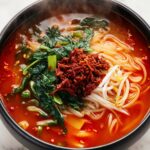
Korean Spicy Beef Vegetable Soup Recipe
- Prep Time: 20 minutes
- Cook Time: 50 minutes
- Total Time: 1 hour 10 minutes
- Yield: 8 servings
- Category: Soup
- Method: Stovetop
- Cuisine: Korean
Description
This Korean Spicy Beef Vegetable Soup features tender beef brisket simmered in a flavorful homemade broth with a variety of vegetables and a spicy chili oil made from Korean chili flakes and sesame oil. The soup is infused with traditional Korean seasonings like gochujang, soy sauce, and anchovy sauce, delivering a harmonious balance of spicy, savory, and umami flavors. Perfect for a comforting meal that highlights authentic Korean tastes.
Ingredients
Dried Vegetables
- 0.8 oz (22g) dried fernbrake
- 1 oz (28g) dried taro stem (optional)
Fresh Vegetables
- 8 oz (225g) mung bean sprouts
- 5 oz (140g) oyster mushrooms (or shiitake), torn into bite-size pieces
- 2 Asian leeks
- 1 large onion, cut in half
- 1 whole garlic, cut in half
- 3 cloves garlic, minced
- 1/2 lb (225g) Korean radish, cut into large chunks
Meat
- 1 1/4 lb (560g) beef brisket
Seasonings & Sauces
- 1 teaspoon Korean chili paste (gochujang)
- 1 tablespoon soy sauce
- 3 tablespoons Korean soup soy sauce (gukganjang)
- 1 1/2 tablespoons Korean anchovy sauce
- Salt and pepper, to taste
- 3–4 tablespoons Korean chili flakes (gochugaru)
Oils
- 2 tablespoons oil
- 2 tablespoons sesame oil
Liquids
- 14 cups (about 3 liters) water
Instructions
- Rehydrate Dried Vegetables: Boil the dried fernbrake and taro stem separately until they are softened. After boiling, soak them for 1 hour to fully rehydrate. Drain, rinse under cold water, and slice the vegetables into manageable pieces.
- Make Beef Stock: In a large stockpot, combine the onion halves, whole garlic halves, Korean radish chunks, and beef brisket with 14 cups (about 3 liters) of water. Bring this mixture to a boil over high heat, then reduce heat to low and simmer gently for 45 minutes to develop a rich, flavorful stock.
- Strain Stock and Prepare Beef: After simmering, discard the vegetables from the pot. Remove the beef brisket and shred it into bite-sized pieces. Strain the stock to remove any solids and keep it reserved for later use.
- Blanch Fresh Vegetables: Prepare the Asian leeks by cleaning and cutting them as desired. Bring a pot of salted boiling water and blanch mung bean sprouts, mushrooms, and leeks for a few seconds until slightly softened but still crisp. Drain the vegetables and rinse under cold water to stop cooking, then squeeze out any excess water.
- Make Chili Oil: In a separate pot or saucepan, heat the oil and sesame oil over low heat. Add the Korean chili flakes (gochugaru) and stir constantly for about 30 seconds to infuse the oil with a spicy, smoky flavor without burning the flakes.
- Combine and Simmer Soup: Add the blanched vegetables and shredded beef to the pot with the chili oil. Pour in the reserved beef stock and stir to combine. Add the Korean chili paste (gochujang) and bring the soup to a gentle simmer. Cook for 15-20 minutes to allow all the flavors to meld.
- Season Soup: Finish by seasoning the soup with soy sauce, Korean soup soy sauce (gukganjang), and Korean anchovy sauce. Adjust salt and pepper to your taste. Stir well and serve hot for a comforting and spicy Korean beef vegetable soup experience.
Notes
- Soaking and boiling the dried vegetables separately helps remove any earthy bitterness and ensures they soften evenly.
- Using both soy sauce and gukganjang (Korean soup soy sauce) adds depth of flavor and a balanced saltiness.
- Adjust the amount of Korean chili flakes (gochugaru) and chili paste (gochujang) to control the spiciness level.
- Beef brisket is preferred for its tenderness and rich flavor after slow simmering.
- If dried taro stem is unavailable, you may omit it or substitute with other dried vegetables like dried fiddleheads.

